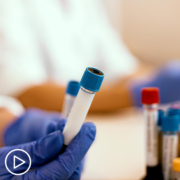Shared Decision-Making: The Patient’s Role in Treatment Choices
Shared-Decision Making: The Patient’s Role in Treatment Choices from Patient Empowerment Network on Vimeo.
What is the role of the patient when it comes to treatment choices? Dr. Brady Stein details how he partners with patients in decision-making for their MPN care.
Dr. Brady Stein is a hematologist focusing on myeloproliferative neoplasms (MPNs) at the Robert H. Lurie Comprehensive Cancer Center of Northwestern University. Learn more about Dr. Stein, here.
Related Resources

|

An Expert Shares Key Steps to Take Following an MPN Diagnosis |

|
Transcript:
Katherine:
What do you feel is the patient’s role in the decision for therapy?
Dr. Stein:
I think it’s a really important role. I think historically – and, this is decades past; this era should be well over and behind us – this era of authoritative medicine is over.
You can’t just have a doctor walk in the room and say, “This is your treatment, this is what you should do, I’ll see you later.” It’s shared decision-making, and that can be troubling for some patients. But, the idea of shared decision-making is us explaining options informing the patient and making decisions together. That’s really the paradigm for modern contemporary medicine.
Some patients have a harder time with that. A lot of patients say, “Well, doc, this is too overwhelming for me. I just want you to decide for me.” And, we try not to do that. That’s a more uncomfortable type of visit for me when a patient is very deferential and says, “Whatever you say, I’ll do.” That’s not really what we want to hear. I want to know that you feel really informed, that you have a good understanding because each of these treatments – any treatment, any medication has its pros and cons.
There are no real magic bullets, and each upside has an equal downside, so you have to engage and open a dialogue, and what that means is that patients need to read and learn. That’s hard, but patients need to become proactive in their approach to their own illness, and all the patients who are listening now are doing that, trying to get more education about your relatively rare illness that’s going to give you a much better framework to help make decisions together.
Katherine:
Absolutely. If a patient isn’t feeling confident with their treatment plan or their care, do you recommend that they maybe consider a second opinion or seek a specialist?
Dr. Stein:
Of course, yeah. These are rare diseases, and patients often – I would say that in my clinic, a lot of the patients direct their own second opinions. Oftentimes, it’s coming from the patient more so than their doctor. I think the patient community is very active, the patients are networking, and they’re finding the right specialist to get to.
I think it should be really a team approach. It’s never – it’s usually not very convenient to go to a university unless you live really close, so you want to have someone close to home who can handle the routine, and then, someone who maybe is a little bit further away who can see you once a year, can help with the big decisions, can be part of the healthcare team. So, we generally recommend that you have someone near, and that maybe you have someone far who focuses only on MPNs as part of your team, and now, it’s a little different. Telemedicine is becoming a pretty ingrained part of medicine. It’s a little easier to have those visits with a physician who’s far away because of telemedicine.










